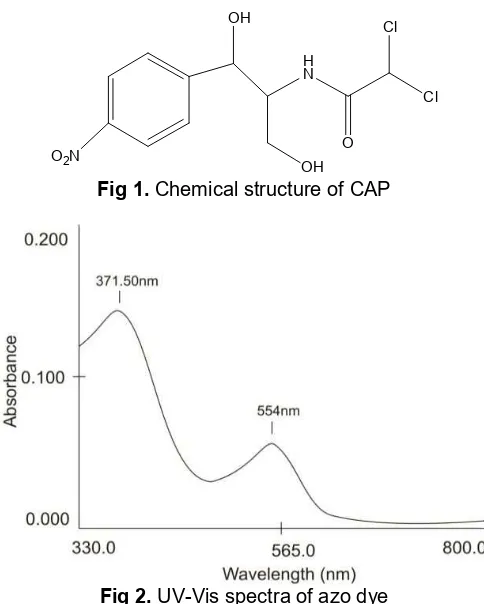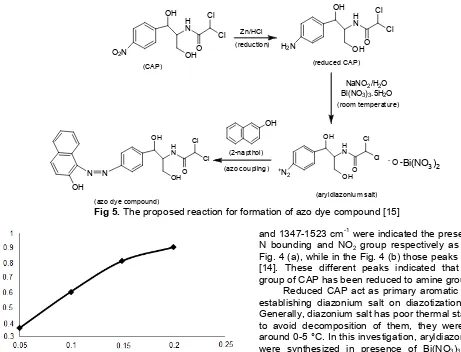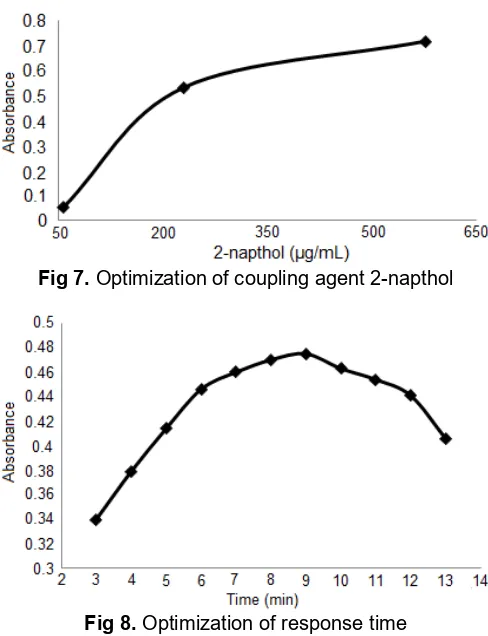Indones. J. Chem., 2016, 16 (1), 32 - 35
Abdul Wafi et al.
32
* Corresponding author.
Email address : [email protected]
A Novel Spectrophotometric Method for Determination of Chloramphenicol Based On
Diazotization Reaction at Room Temperature
Abdul Wafi
1,4,*, Ganden Supriyanto
2,3, and Tjitjik Srie Tjahjandarie
2 1Department of Medical Laboratory Technology, Maharani College of Health Science Jl. Simpang Candi Panggung No. 133 Malang, Indonesia
2
Department of Chemistry, Faculty of Science and Technology, Airlangga University Jl. Mulyorejo Kampus C UNAIR Surabaya, Indonesia
3
Laboratory of Biosensor, Institute of Tropical Disease, Airlangga University Jl. Mulyorejo Kampus C UNAIR Surabaya, Indonesia
4
Department of Pharmacy, Faculty of Science and Technology, Maulana Malik Ibrahim Islamic State University Jl. Gajayana No. 50 Malang, Indonesia
Received January 21, 2015; Accepted May 6, 2015
ABSTRACT
An analytical method for determination of chloramphenicol (CAP) based on the diazotization reaction at room temperature has been developed. The CAP was reduced using zinc powder (Zn) and diazotization reaction was carried out at room temperature in the presence of NaNO2, bismuth nitrate pentahydrate (Bi(NO3)3.5H2O) as catalyst. 2-napthol was used as coupling agent to form a red-violet solution and the absorbance was measured by UV-Vis spectrophotometer at 554 nm. The optimization of analytical parameters including reducing agent, catalyst, coupling agent and time response were 0.15 g, 0.15 g, 230.67 µg/mL and 8-9 min respectively.
Keywords:azo dye; chloramphenicol; diazotization reaction; spectrophotometry
ABSTRAK
Sebuah metode analitik telah dikembangkan untuk penentuan kloramfenikol (CAP) berdasarkan reaksi diazotasi pada suhu kamar. CAP direduksi dengan menggunakan serbuk seng (Zn) dan reaksi diazotasi dilakukan pada suhu ruang dengan mereaksikan NaNO2, bismut (III) nitrat pentahidrat (Bi(NO3)3.5H2O) sebagai katalis. 2-naftol digunakan sebagai agen pengkopling untuk membentuk senyawa azo yang berwarna merah-ungu dan absorbansi diukur dengan spektrofotometer UV-Vis pada panjang gelombang 554 nm. Optimasi parameter analitik diantaranya agen pereduksi, katalis, agen pengkopling dan waktu respon masing-masing 0,15 g, 0,15 g, 230,67 µg/mL dan 8-9 menit.
Kata Kunci:senyawa azo; kloramfenikol; reaksi diazotasi; spektrofotometri
INTRODUCTION
Chloramphenicol (CAP), is an antibiotic drug. It is broad spectrum antibiotic, isolated from streptomyces venenzuelae. Chloramphenicol is effective against a wide variety of Gram-positive and Gram-negative bacteria, including most anaerobic organisms. It is widely used because it is inexpensive and readily available. The most serious adverse effect associated with CAP treatment is bone marrow toxicity, which may occur in two distinct forms: bone marrow suppression, which is a direct toxic effect of the drug and is usually reversible, and aplastic anemia, which is idiosyncratic (rare, unpredictable, and unrelated to dose) and generally fatal [1-3]. European Commission, the United States and some other countries have strictly banned
the use of CAP in drug and food product as in eggs, honey, milk and shrimp [4]. The chemical structure of CAP was shown in Fig. 1.
Indones. J. Chem., 2016, 16 (1), 32 - 35
Abdul Wafi et al.
33
O2N
H N
Cl
Cl
O OH OH
Fig 1.Chemical structure of CAP
Fig 2.UV-Vis spectra of azo dye
catalyst and 2-napthol as coupling agent to form azo dye. The analytical parameters including optimization of reducing agent, catalyst, coupling agent and time response for formation of azo dyes had been investigated.
EXPERIMENTAL SECTION
Materials
CAP reference standard was purchased from Sigma Aldrich, Singapore. Bi(NO3)3.5H2O was purchased from Merck, Germany. Ethanol, sodium nitrite, concentrated hydrochloric acid, 2-napthol and zinc powder were pure analytical grade.
Instrumentation
The instrumentals were used, including spectrophotometry UV-Vis Shimadzu-1800, Fourier Transform Infra Red (FTIR) Shimadzu-8400S, and glassware.
Procedure
Preparation of reagent
CAP (0.1000 g) was weighed quantitatively and dissolved in ethanol. The solution was transferred to a
100 mL volumetric flask and made up with same solvent to mark.
NaNO2(0.5520 g) was weighed quantitatively and dissolved in distilled water. The solution was transferred to a 100 mL volumetric flask and made up with distilled water to mark.
2-napthol (0.0576 g) was weighed quantitatively and dissolved in 50 mL ethanol. The solution was transferred to a 100 mL volumetric flask and made up with distilled water to mark.
Reduction of CAP
A 2.50 mL of CAP solution 969.39 µg/mL was transferred to a 50 mL glass beaker and added 1 mL distilled water, 1 mL concentrated hydrochloric acid and zinc powder, allowed for 15 min. Then the solution was filtered and transferred quantitatively to a 25 mL volumetric flask and made up with distilled water to mark. The reduced CAP was characterized with FTIR.
Preparation of azo dye solution
Bi(NO3)3.5H2O (0.15 g) was weighed quantitatively in a 50 mL glass beaker and added 2 mL NaNO2solution, 3 mL of reduced CAP solution. Then, 3 mL of 2-napthol was added and allowed at room temperature for 8-9 min. The solution was filtered and transferred to a 25 mL volumetric flask, and made up with distilled water to mark. The absorbance of azo dye solution was measured with UV-Vis spectrophotometer at 554 nm.
The spectral data of CAP and azo dye
Non-reduced CAP : FTIR (KBr) cm-1: 3377, 2935, 2841, 2520, 2145, 1649, 1448, 1408, 1019, 872, 658. Reduced CAP : FTIR (KBr) cm-1 : 3485, 2922, 2841, 2359, 2065, 1636, 524. Azo dye compound (reduced CAP – 2-napthol) : UV-Vis Spectrophotometer (Fig. 2) :
λmax (nm) : 371.50 (π - π*, Ar-H), 554 (n - π*, N=N).
RESULT AND DISCUSSION
Indones. J. Chem., 2016, 16 (1), 32 - 35
Abdul Wafi et al.
34
NaNO2/H2O Bi(NO3)3.5H2O
-O -Bi(NO
3)2 (room temperature)
OH
+N 2
H N
Cl
Cl
O OH OH H
N Cl
Cl
O OH OH
OH N N
O2N
H N
Cl Cl O OH OH
H2N
H N
Cl Cl O OH OH
Zn/HCl
(reduction)
(CAP) (reduced CAP)
(aryldiazonium salt) (azo dye compound)
(2-napthol)
(azo coupling)
Fig 3.Optimization of CAP reduction by zinc powder Fig 4. (a) FTIR spectra of non-reduced CAP, and (b) reduced CAP
Fig 5.The proposed reaction for formation of azo dye compound [15]
Fig 6.Optimization of catalyst Bi(NO3)3.5H2O
The spectra of FTIR showed different peak between non-reduced CAP and reduced CAP as shown in Fig. 3. The typical peaks for primary amines were found at 3220-3500 cm-1for N-H stretch and at 1617 cm -1
for N-H bend. However, the Fig. 3 (a) and fig. 3 (b) were difficult to distinguish because the N-H peak overlapped with O-H at 3300-3500 cm-1 and with C=O stretch at 1640-1700 cm-1. The FTIR spectra at 852 cm-1
and 1347-1523 cm-1were indicated the presence of C-N bounding and C-NO2 group respectively as shown in Fig. 4 (a), while in the Fig. 4 (b) those peaks disappear [14]. These different peaks indicated that the nitro group of CAP has been reduced to amine group.
Reduced CAP act as primary aromatic amine for establishing diazonium salt on diazotization reaction. Generally, diazonium salt has poor thermal stability and to avoid decomposition of them, they were handled around 0-5 °C. In this investigation, aryldiazonium salts were synthesized in presence of Bi(NO3)3.5H2O as catalyst. So that the aryldiazonium salts will be kept stable at room temperature [15].
Indones. J. Chem., 2016, 16 (1), 32 - 35
Abdul Wafi et al.
35
Fig 7.Optimization of coupling agent 2-napthol
Fig 8.Optimization of response time
The optimization of catalyst and coupling agent showed the increasing of absorbance due to the increasing of mass of Bi(NO3)3.5H2O and concentration of 2-napthol respectively. Thus, it indicated the increasing of azo dyes. The optimum result of Bi(NO3)3.5H2O and 2-napthol at 0.15 g and 230.67 µg/mL respectively, as shown in Fig. 6 and Fig. 7. The response time for formation of azo dye compounds has been investigated. In the Fig. 8 was shown the response time optimization of reduced CAP-2-napthol which showed the increasing of absorbance after 3-9 min but subsequently decreasing because of decomposition of azo dye. The optimum result of response time for formation of azo dye was for 8-9 min. Thus, the proposed method was not taken a long time. So, it is more effective for analysis.
CONCLUSION
We have successfully demonstrated the spectrophotometric method for determination of CAP based on diazotization reaction at room temperature.
From the present study it can be concluded that this method has simple methodology, easy work-up, short reaction times and low cost.
ACKNOWLEDGEMENT
The authors are grateful to Analytical Laboratory of Chemistry Department of Airlangga University, Surabaya, Indonesia for providing the facilities to carry out this research work.
REFERENCES
1. Liu, W.L., Lee, R.J., and Lee, M.R., 2010, Food Chemis., 121 (3), 797–802.
2. Alizadeh, T., Ganjali, M.R., Zare, M., and Norouzi, P., 2012,Food Chem., 130 (4), 1108–1114.
3. Yang, S.Y., Ho, C.S., Lee, C.L., Shih, B.Y., Horng, H.E., Hong, C.Y., Yang, H.C., Chung, Y.H., Chen, J.C., and Lin, T.C., 2012, Food Chem., 131 (3), 1021–1025.
4. Chen, H., Ying, J., Chen, H., Huang, J., and Liao, L., 2008,Chromatographia, 68 (7), 629–634. 5. Lindino, C.A., and Bulhoes, L.O.S., 2004, J. Braz.
Chem. Soc., 15 (2), 178–182.
6. Jin, W., Ye, X., Yu, D., and Dong, Q., 2000, J. Chromatogr. B, 741 (2), 155–162.
7. Karaseva, N.A., and Ermolaeva, T.N., 2012, Talanta,93, 44–48.
8. Viñas, P., Balsalobre, N., and Hernández-Córdoba, M., 2006,Anal. Chim. Acta, 558 (1-2), 11–15. 9. Bogusz, M.M., Hassan, H., Al-Enazi, E., Ibrahim,
Z., and Al-Tufail, M., 2004, J. Chromatogr. B, 807 (2), 343–356.
10. Gantverg, A., Shishani, I., and Hoffman, M., 2003, Anal. Chim. Acta, 483 (1-2), 125–135.
11. Scortichini, G., Annunziata, L., Haouet, M.N., Benedetti, F., Krusteva, I., and Galarini, R., 2005, Anal. Chim. Acta, 535 (1-2), 43–48.
12. Lv, Y.K., Wang, X.H., Zhang, W., Yang, L., and Liu, P., 2012,IJSID, 2 (6), 610–616.
13. Shelke, S.P., and Thorat, M., 2013,IRJIPS, 1 (1), 27–29.
14. Silverstein, R.M., and Webster, F.X., 1998, Spectrometric Identification of Organic Compounds, 6th Ed., John Wiley and Sons Inc., New York.


